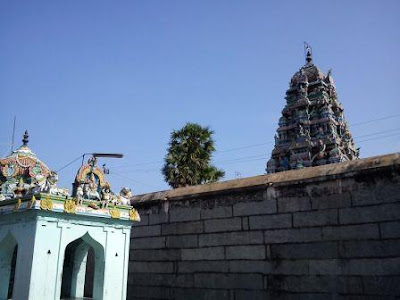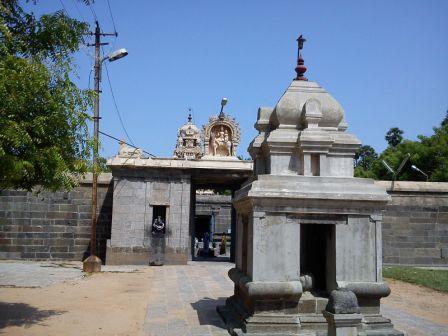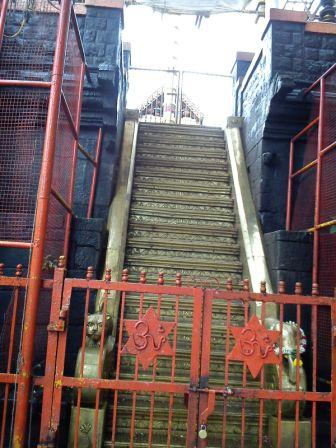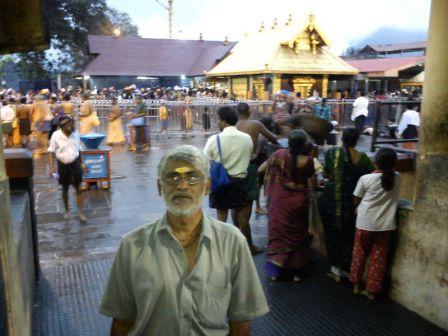12,
July 2011.
In Continuation to my Paadal Petra
sthalangal darshan, I had been to the following three
Paadal Petra Shiva Sthalangal (in Nadu Naadu) near Villupuram on 09-07-2011 .
53/21. SRI ABIRAMESWARAR TEMPLE, THIRUVAMATHUR
53/21. SRI ABIRAMESWARAR TEMPLE, THIRUVAMATHUR
Now
this place is called as Thiruvamathur. It is the 21st Moovar
Paadal Petra sthalam of Nadu Naadu.
Iraivan: Sri Abirameswarar, Sri Azhakia nathar
Iraivan: Sri Abirameswarar, Sri Azhakia nathar
Iraivi
: Sri Multhambigai, Sri Azhakia Nayagi.
Some of the important features of this temple are ....
Some of the important features of this temple are ....
The temple is facing east with a 7 tier Rajagopuram. Balipedam, Dwajasthambam and Rishabam are immediately after the Rajagopuram. This
is one of the temple where the Ambal temple is facing west, separately built opposite to Shiva
temple. There are two Nandhis. One is big and is made of sudhai / Stucco and
the other one is stone located in a Pit. Purpose of Nandhi in a pit is to
pray Shiva to get rain, by immersing Nandhi in water.
Vattaparai
Amman Sannathi is famous here, which is south west corner of the Ambal temple.
To find out the truth of a guilty person, the person will have to do sathyam in
front of the Amman
HOW TO REACH :
Town
buses are available from Main bus stand. Route nos 22,8C, 32, 6E and 18. Buses
going to Mel Gudalur and Elu Sempon is going via this temple.
Mini
bus also available from the old bus stand.
To
catch bus, better to wait at Hospital Stop signal, Villupuram ( Chennai buses
also pass through this stop )
CONTACT DETAILS:
Telephone
and mobile numbers are +91 4146 223379 and +91 98430 66252
LOCATION OF THE TEMPLE : CLICK
HERE
Moolavar
Rajagopuram with kodimaram and Ambal temple on the other side of the road
Rajagopuram is also visible
A
big Sudhai nandhi and a small ( Stone ) kal nandhi below the ground level
under the mandapam
View of Shiva Temple Rajagopuram with Ambal temple gopuram
view from Ambal temple
52/20. SRI PANANGATEESWARAR TEMPLE, PANAYAPURAM
( PURAVAR PANANGATTUR )
( PURAVAR PANANGATTUR )
This
temple is 20th Paadal
Petra Shiva sthalam of Nadu Naadu. Saint Thirugnanasambandar has sung hymns in praise of Lord Shiva of this temple,
Now this place is called as Panayapuram.
Iraivan
: Sri Panangateeswarar
Iraivi
:: Sri Sathyambigai, Sri Puravammai.
Some
of the important features of this temple are...
The
temple is facing east with a 4 tier Rajagopuram. Palipedam, Dwajasthambam and
Nandhi are immediately after the Rajagopuram. It is one of the five Shiva
temples, in which Palm Tree as sthala vruksham. There are separate
sannadhis for Ambal and Sri Murugan, both are are facing East.
This
temple was under threat of shifting to give way for road expansion and the road
alignment was changed after public protest.
This
temple was built by Chola King Kulothungan -I.
HOW TO
REACH :
From
Chennai to Villupuram get down at Mundiambakkam. The buses going to
Pondicherry via Mundiambakkam is going through Panayapuram.
From
Chennai to Neyveli, Panruti, Thanjavur, 2 KM after Vikravandi get down at
Panayapuram.
Auto/
Share autos are available from Mundiambakkam Sugar Factory opposite side. 3 KM
from Mundiambakkam.
CONTACT DETAILS
CONTACT DETAILS
( Moolavar vimanam with Vinayagar sannadhi
Siva Lingam under the Palm tree the sthala viruksham
( Ambal sannadhi vimanam )
Ambal sannadhi entrance
Front view of the temple with Dwajasthambam
Arumuganar with Lakshmi
Rajagopuram 4 tier
48/16. PANCHANATHEESWARAR TEMPLE/ VADUGURNATHAR TEMPLE, VADUKUR - THIRUVANDARKOIL
It
is a 16th Temple in Nadu Nadu Saint Thirugnanasambandar
Paadal Petra sthalam. Now the place is called as Thiruvandarkoil.
Iraivan
: Sri Vadugeeswarar, Sri Vatugunathar, Sri
Vatugurnathar
Iraivi
: Sri Thirupurasundari, Sri Vadukirkanni
Some
of the important features of this temple are ....
The
temple is facing east with a Balipeedam and Rishabam. The temple do not have the
Dwajasthambam and Rajagopuram. A base of a mandapam is on the right side of the
Nandhi & Palipedam. The Koshtams has the Chozha period statues. In the outer prakaram sannadhi for Vinayagar and Valli Devasena Subramaniar.
This
temple was built by Chozha Kings, similar to Thanjavur Rajarajecharam / Peria Temple
Legend: It was
believed that Vadugu Bhairavar worshiped Lord Shiva to get rid of the sin caused by killing demon / Asuran
Mundakan.
CONTACT DETAILS
Sundara Moorthy Gurukkal may be contacted on his mobile number +91 9698886111, for further details.
HOW TO REACH :
All
the buses from Villupuram to Puducherry pass through Thiruvandarkoil. The
temple on the road side opposite to Food Corporation Go-down.
After
visiting Panayapuram Panagateeswarar, Via Koliyanur koot road, we can reach
this temple, through bus to Puducherry.
LOCATION OF
THE TEMPLE : CLICK HERE
Stone velaipadu moolavar vimanam
Vinayagar sannadhi
Moolavar vimanam
Palipeedam with nandhi there is no Dwajasthambam (kodimaram)
Temple entrance with nandhi mandapam
--- OM SHIVAYA NAMA ---























































